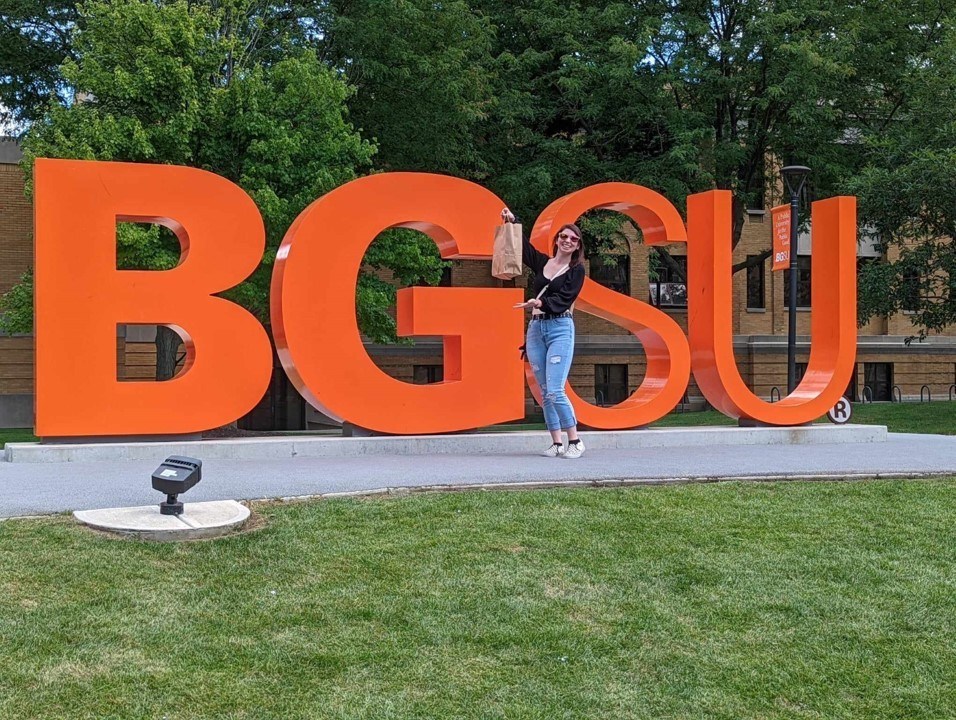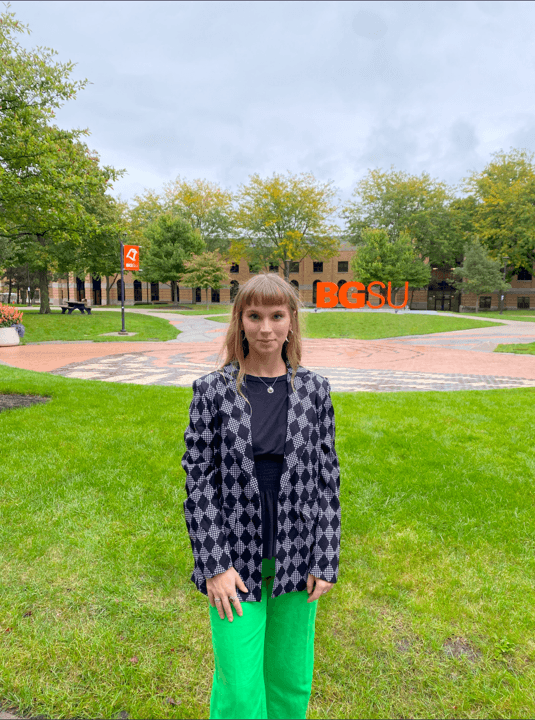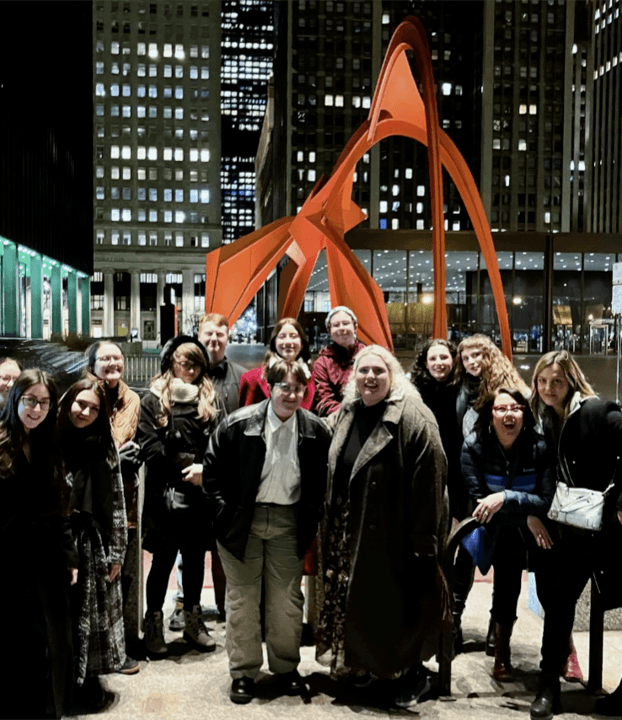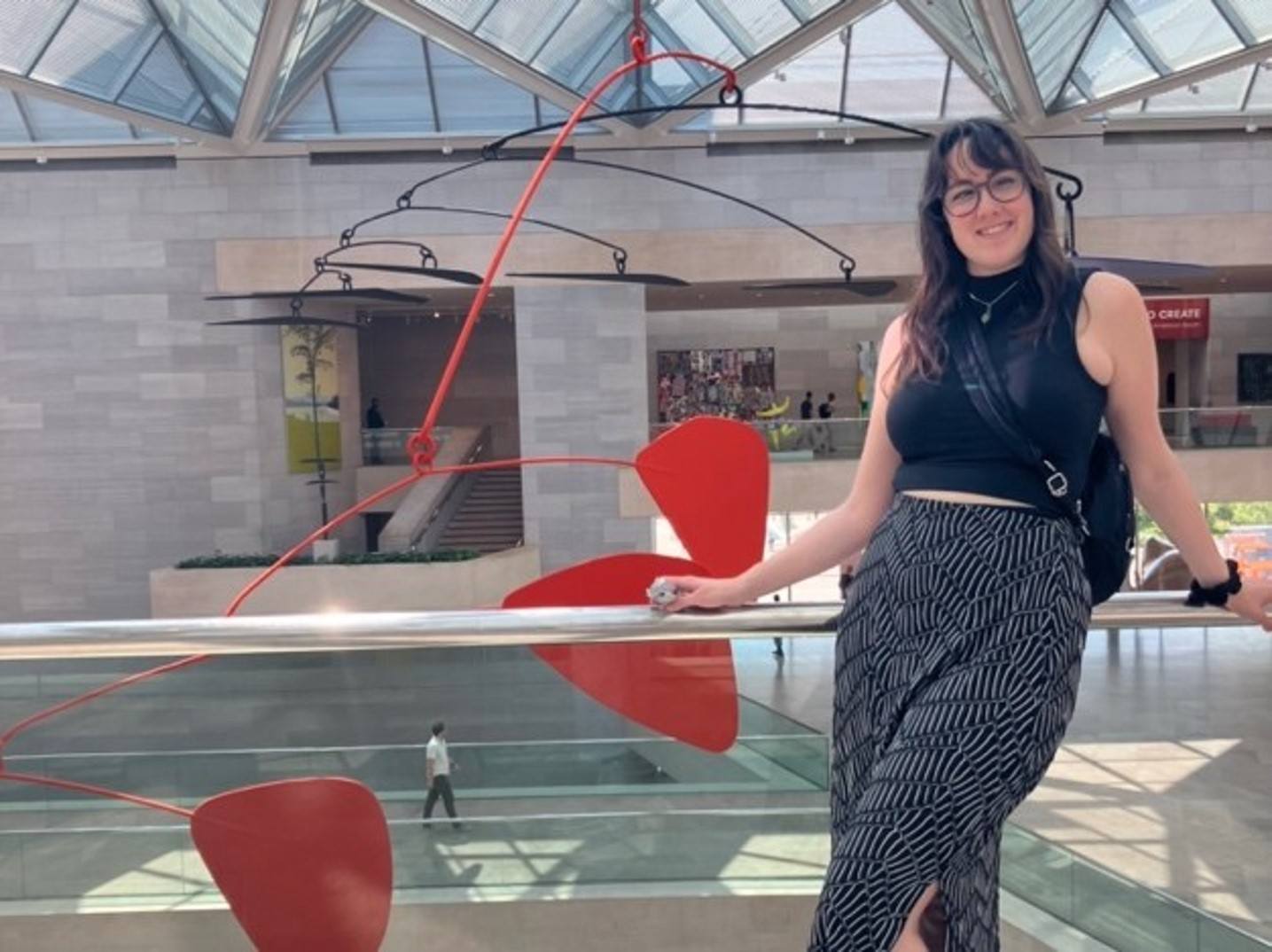2024 News
M.A. Candidate in Art History, Anastasia Michalak
Written by Samantha Imrie (M.A. candidate, Art History, BGSU 2025)
This Art History Spotlight features M.A. candidate, Anastasia Michalak, who is dedicated to the study of Japanese manga and anime. Anastaisa has always been interested in Japan and Japanese culture; she received her B.A. in Asian Studies from the University of Toledo. Before coming to BGSU to pursue her M.A. in Art History, she worked as a substitute teacher, which was highly altered by the COVID-19 Pandemic. She decided to change careers and pursue a master's degree in art history to build upon her Asian studies background.
Anastasia’s close connection to the Toledo Museum of Art is part of what inspired her to pursue a career in the arts. She grew up visiting the Toledo Museum of Art frequently with her grandmother and, more recently, worked at the museum as a volunteer on their “Art of Conservancy” exhibition, assisting with the curatorial process. She believes the experience of going behind-the-scenes in the planning and staging of the exhibition was invaluable. Furthermore, when the exhibition opened to the public, she was in the gallery to greet visitors and shared information with them. Since this exhibition was about conservancy, the TMA conservators organized scholarly panels on topics and hosted events to discuss conservation issues with the public. Anastasia found it especially gratifying to be involved in such a unique and educational exhibition.
"Pop culture is important, period. I mean, look at classic rock that was pop culture during the time, or classic literature. Shakespeare was pop culture at one time.”
Anastaisa is planning on writing her thesis on Japanese manga and anime. She has been interested in anime and manga since childhood and grew up watching Studio Ghibli films, Sailor moon, and Pokémon. Her thesis research will explore themes of identity and hybridization in anime and manga, as well as consider new possibilities in formats and distribution of those art forms with emerging technologies and the ever-evolving uses of the internet.
Part of her motivation to write an art history thesis about manga and anime is to challenge traditional foci within the discipline and shed light on the creative expression of this popular art. As she explains, to some “it sounds crazy and coming into this, I didn't think I was going to be able to... because I think there's a very stereotypical idea of what art is within scholarship and even within the general public. I think scholarship is coming to terms with it quicker than the public, that manga and anime are actual art forms. Yeah, it might be pop art, but it doesn't mean that it is any less relevant or important than the more like higher end or highbrow arts.”
As part of her graduate studies at BGSU, Anastasia studied abroad in Japan on a summer field experience organized by faculty in the School of Art and the Department of Popular Culture. Students on the program were introduced to traditional Japanese art forms and notable traditional structures as well as more modern and pop-culture centered areas such as Akihabra, the anime and gaming district, and Harajuku, famous for its street fashion. “I really love the Studio Ghibli movies and anime in general, so I was really excited to truly see and experience where the inspiration behind these fantasy-scapes and magical worlds comes from.” Anastasia was able to visit multiple exhibitions dedicated to manga and anime and drew inspiration from their display strategies and information sharing.
“A lot of people have defended manga and anime [as legitimate works of art], but it's still an up-and-coming field and I'd love to be in that; I'd love to be in the middle of that just so I could be informing the next generation and encouraging people to pursue things that they love”
Anastaisa appreciates the mentoring she has received so far in her time at BGSU. “I think I'm very fortunate because Professor Terry-Fritch is very outside of the box in her research interests. For example, she taught a Renaissance banqueting culture seminar and she hoped that by the end of the class we would realize that this [banqueting, and all of the material and performative conditions surrounding banqueting] is an art. That struck a chord with me because I think that that is not necessarily the traditional way that we see ‘Art’.”
Anastasia really appreciates the one-on-one attention she has gotten at BGSU and believes that employers will value BGSU graduates like herself because they have more experience engaging with professors and arts professionals. After her M.A., Anastasia is considering going on to the PhD level of study to continue her research on anime and manga. She ultimately would like to work as a curator for a museum. We cannot wait to learn more about her M.A. thesis, and we wish her luck in the writing process!

Art History Senior Rose Brookhart, Completes Internship at Santo Spirito in Florence Italy
Written by Samantha Imrie (M.A. candidate, Art History, BGSU 2025)
Rose Brookhart (B.A., Art History, BGSU 2024) had the opportunity to complete a rare art history internship at the Basilica of Santo Spirito spend in Florence, Italy, during Summer 2023. As part of her study abroad experience at BGSU School of Art’s partner school, International Studies Institute (ISI), Rose trained to be an art history guide and gave English spoken tours to visitors to the basilica.
Rose began her degree at BGSU in 2020 and, despite COVID, had a wonderful experience in the first semester. She recalls thinking how lovely the town and campus were on her first visits: “The atmosphere here, the camaraderie, I really love. Perhaps I’m biased but I feel that genuinely there is a community here for everyone.” Since she grew up in Cleveland, and was always enamored with the Cleveland Museums of Art’s impressive Asian Collection, it surprised her that she decided to study Italian Renaissance Art. She initially took Renaissance classes with Dr. Terry-Fritsch and found her passion. When Rose decided to study abroad at ISI-Florence, she wanted to gain professional experience in Florence in addition to taking art history and history classes. With the help of Dr. Terry-Fritsch, who is the BGSU coordinator for the ISI-Florence program, Rose was offered the first art history internship for an American student at the Basilica di Santo Spirito.
“Teaching is something that I still have not ruled out, but art history has to be part of my life!”
The Basilica di Santo Spirito is a functioning Augustinian church and convent as well as an exemplar of Renaissance architecture and art. At Santo Spirito, Rose was excited to have the freedom to structure her tours how she wanted and integrate her own research. Stefano Corazzini, Italian architecture historian and professor at ISI, was her research advisor and mentor throughout her internship. In addition to the independent research that she performed to prepare herself, Corazzini guided her through educational tours of important museums and landmarks. Rose said his energy inspired her own tours at Santo Spirito, “Stefano said to me that your tours are like doing a puzzle. Every time you do it, you’re going to put it together a little differently. Maybe you’ll forget a piece one day, maybe you’ll remember something one day, but every time you do it, it's like putting a puzzle together.” The star of the collection at Santo Spirito is a crucifix attributed to Michelangelo which she made sure to include in all her tours, otherwise she had a lot of creative freedom on the story that she wanted to tell and how she wanted to engage the visitors, “That’s how I want to educate people, my desire to share my knowledge is coupled with my own need to do my own investigations and nourish my own passions of research.”
“The BGSU Art History Department made me prepared for everything I needed there.”
Rose found the experience of living internationally to be enriching and empowering. She appreciated all the research skills and foundational knowledge she had gained from her classes. She described an example: “I was working on a project in Dr. Terry Fritsch’s class on apothecaries last fall and one of the things she told me to think about while I was writing the paper was to think about the neighborhood, how the city is organized, and how that impacts what you’re researching. And when I got to Florence, I was like, yes, it does. Florence is such an interconnected city, and it impacts the understanding of the art.” In Rose’s experience, the BGSU Art History faculty do an excellent job of helping students to feel capable of applying their knowledge in the world.
“This department has enriched my life beyond anything I can ask for.”
Rose believes promoting community around what you love is an important way to give back. She was part of a small group of students that resurrected the Art History Association (AHA) after COVID and served as its President. In addition to her coursework, involvement in student government, and her duties as the President of AHA during her final year at BGSU, she applied to various art history master's programs. She says her internship made her sure of her next steps: “Over the summer during my internship, just being in the presence of everything that I loved, getting to research everything I loved to study, I realized there’s just no question so there is no reason to wait; this is what this is what I’m passionate about.” Rose was awarded a Kress Fellowship to attend the Syracuse University Florence Master’s Program in Italian Renaissance Art and began her graduate studies in Fall 2024! We all wish her the best of luck and know she will make us Falcon proud!

The Art History Association Attends the College Arts Association Annual Conference
Written by Samantha Imrie (M.A. candidate, Art History, BGSU 2025)
“Being able to send 20 students, undergraduates and graduates, to the College Art Association Conference in Chicago and introducing them to so many professional opportunities was really satisfying. It was great to see them awakening to the idea that they can contribute to the future of their disciplines.”
-Charles Kanwischer, Director of The School of Art
Thanks to generous funding from the School of Art Division of Art History and the Ring Fund, BGSU students from the Art History Association and the Graduate Arts organization attended the 112th Annual Conference of the College Arts Association (CAA) in Chicago. CAA is the preeminent international leadership organization in the visual arts; its mission is to promote the arts and their understanding through advocacy, intellectual engagement, and a commitment to the diversity of practices and practitioners. The CAA Annual Conference is the largest convening of art historians, artists, designers, curators, and visual arts professionals and features specialized sessions on diverse aspects of new research in the arts. Students attended conference panels of their choice and had the opportunity to visit the collections of works of art at the Chicago Art Institute, Museum of Contemporary Art (MCA) Chicago, and The Institute for the Study of Ancient Cultures Museum at the University of Chicago.
Allie Terry-Fritsch, Professor and Chair of Art History, and the primary faculty organizer for the trip, describes travel as part of the professional identity of an art historian: “We need to examine and analyze works of art in person, thus any opportunity to visit a new city presents an opportunity to learn new information about works of art held in collections there. I encourage all my students to travel as often as possible, whether here in the US or abroad, but some have never had the chance to even leave Ohio. The Chicago trip was designed to introduce students to independent travel and research. Students visited major collections of art and attended scholarly lectures at the conference, then were able to explore the urban center and experience the ‘big city.’"
Beyond the scheduled educational and cultural activities, Terry-Fritsch recognizes the trip was important for student socialization within the Art History division. The Chicago trip was once an annual occurrence for Art History majors, but since the Covid-19 pandemic, the School of Art had scaled back on extracurricular activities and student social life has suffered. The Art History Association was dissolved during the pandemic and, in Fall 2023, was revived by a small group of undergraduate students, who rewrote the organization's constitution and reactivated its status on campus. The recent Chicago trip capped a year-long series of student-centered activities sponsored by AHA and the Art History faculty, including local museum trips and attendance at guest lectures, participation in arts events and campus-wide festivals, professionalization workshops, student wellness nights, and more.
Students who have participated in these events through AHA have formed close friendships and profess an increased sense of belonging at BGSU. Some students who attended the Chicago trip claim that it helped clarify future goals and belief in a future as an art historian. But the best consequence of a student field trip is to watch how students mature and assimilate their new-found confidence into their outlook once they return to campus.
“As an Art History undergrad, I have big dreams of completing a doctorate and becoming an Art History professor, but I felt this goal was unattainable for me. This trip really opened my eyes and showed me that I can achieve my goals if I put in the work! My dreams seem so much more attainable because of the Chicago trip, and I am incredibly grateful for the experience!” -Rachel Wentling, AHA Treasurer 2023-2024
Rose Brookhart, President of the Art History Association was instrumental in orchestrating and organizing the trip to Chicago. She believes the trip to the CAA Conference was an invaluable academic, professional, and personal experience for herself and the Art History Association at BGSU. The ability to attend the panels at this conference was an opportunity for undergraduate and graduate Art History students to engage with renowned scholars and research. Rose considers that the time spent in Chicago and the CAA Conference was exceptionally motivating for aspiring Art Historians and is grateful for the opportunity to engage with the community of scholars dedicated to the study of art history. The AHA CHICAGO trip provided an occasion for each of the students to bond over their shared dedication and excitement towards Art History.

Art History Alumna Raven Begell-Long on her Internship Experience at the National Museum of the American Indian in Washington D.C.
Raven Begell-Long (B.A., Art History, BGSU 2023) recently returned to campus to share her recent experience as an intern at the National Museum of the American Indian in Washington, D.C. Building on her practical focus on cataloging and collection information systems for museums while an undergraduate Art History student at BGSU (including an internship at the National Museum in our gallery of Trinidad and Tobago), her internship position at the National Museum of the American Indian (NMAI) aligns with her specific academic focus on indigenous issues, indigenous museology, and decolonizing museums.
Collection information systems are the strategies by which a museum organizes all the information it has about its diverse collection of works of art. “Think of it like a database” Begell-Long says, “there are these are systems that organize information about the works. It'll organize what the work is, the name of it, and the information you have about it. Other systems might also include provenance information or information about the artist and their other works, etc. They'll often have to do lists of the tasks a registrar needs to complete to achieve a specific task, whether it's acquiring a work or sending it out for exhibition. So essentially, the collection information systems’ people regulate how information is organized.”
During her internship at NAMI, Begell-Long performed a lot of data standardization for records, such as doing intake and making sure that intake forms are standardized. She also participated in data standardization and data mapping for NMAI's culture thesaurus, which is a vocabulary that lists preferred terms for indigenous people. It helps to remove many of the non-preferred terms or sometimes slurs that have been known to be used against indigenous people. One of her favorite projects has been her work on cultural care notices, which are little, business card sized, pieces of paper that are fitted into mylar sleeves, then attached to specific works in the collection to designate those as having specific protocols. During her internship, the team was able add about 800 of these culture care notices onto objects. For example, a cultural care notice might indicate whether the indigenous community wants you to contact them if you want to post an image of that object, or if only men or male identified individuals can handle certain objects, or any number of designations. She believes it is really important to make sure that collection care is continually and clearly determined by community- informed protocols.
“Well, I think being able to have such a good, grounded community here at BG has been really helpful. I don't think I would be anywhere near the same place in art history if I hadn't come here.”
Many of the Art History courses that she took at BGSU built her ability to think critically and to discuss issues in our collective history. Important to her academic focus was discussing the role of museums, and many of her courses examined thehistory of colonialism, for example in her contemporary classes, which often focused on issues that have arisen in reaction to colonialism, and early modern courses, such as Baroque Art History, when exploration is happening in which Europeans “discover” the so-called “New World”. According to Raven, each distinct area of art history has a wonderful BGSU professor who has helped her towards her focus. She thinks it's a focus that a lot of museums are also shifting towards: rethinking how we reconceptualize the museum. The discussions she’s had at BGSU have led her to this focus. She reflected, “I think what was most significant is to be able to see the threads that lay between things in history and to understand the ways that we can draw conclusions about the art making process and why heritage is important more generally and how institutions hold power like are places that power is and therefore how those institutions have a responsibility to properly and carefully manage and steward their collection.”
“The mission of museums, especially museums like NMAI, are something I believe in. I think they're really important. And that mission being oftentimes connecting people with their heritage.”
As for Raven’s future, she has several exciting upcoming plans. Her research was accepted to the International Conference on the Inclusive Museum, which was presented in Vancouver this September. The conference is focused on bringing forth this dialogue between museum professionals to make museums more inclusive. Her presentation, Amerindians are First Peoples, considers ethical cataloging, practice and terminology in museums and outlines on the decision she helped to facilitate to change the outdated term for Amerindian to first peoples for the National Museum and Art Gallery of Trinidad and Tobago. After the conference, she heads back to NMAI for a second internship continuing her work in collection information systems. After, she plans on continuing in the collection information systems field. She is applying to programs to acquire her Master of Library and Information Sciences degree as well as applying to entry level positions in the field. Her ultimate career goal would be a permanent position at NMAI. We wish her the best of luck in her upcoming internship and all her future goals!

Updated: 09/03/2024 04:37PM
